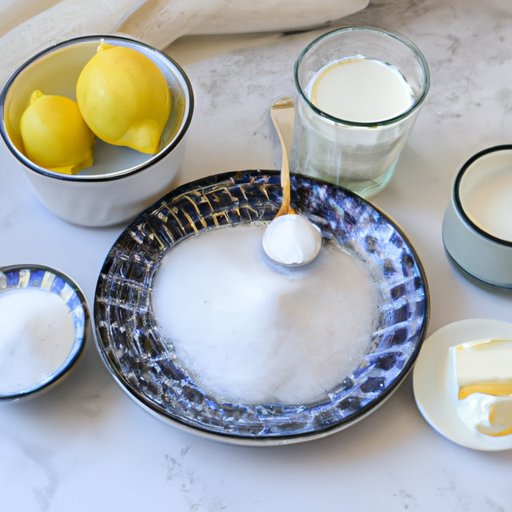
I. Introduction
Buttermilk is a tangy and creamy liquid that is a staple in many recipes, from pancakes to fried chicken. But did you know that you could make buttermilk at home, using just a few simple ingredients? Not only is homemade buttermilk easy to make, but it also has many benefits. In this article, we will explore how to make buttermilk at home, the ingredients you’ll need, as well as some tips to help you get the most out of your homemade buttermilk.
II. Easy Steps to Make Buttermilk at Home
Making buttermilk at home is incredibly easy and only takes three simple steps:
- Pour one cup of milk into a bowl.
- Add one tablespoon of vinegar or lemon juice to the milk and stir.
- Let the mixture sit at room temperature for about 10 minutes or until it curdles.
That’s it! You now have buttermilk. If you need more buttermilk, simply use more milk and vinegar or lemon juice at the same ratio. You can also adjust the recipe to make smaller or larger quantities that suit your needs.

III. 3 Simple Ingredients to Make Homemade Buttermilk
The three simple ingredients you’ll need to make homemade buttermilk are milk, vinegar, or lemon juice. These ingredients are essential for creating the tangy and acidic flavor of buttermilk. It’s important to use high-quality ingredients because it will ultimately affect the taste and quality of your buttermilk. Here are some tips for sourcing the best ingredients:
- Choose milk that is full-fat or whole milk. Low-fat or skim milk will not curdle properly and result in thin buttermilk.
- Use fresh and high-quality vinegar or lemon juice. Fresh lemon juice will be more effective in curdling the milk.
IV. Making Buttermilk from Scratch: Tips and Tricks
While making buttermilk from scratch is relatively simple, there are a few tips and tricks you can use to ensure your buttermilk is thick and flavorful:
- Use the right proportion of milk and vinegar/lemon juice. Too much or too little of either can affect the consistency and flavor of the buttermilk.
- Be patient and wait for the milk to curdle. Do not stir the mixture, as stirring the curdled milk can prevent it from thickening effectively.
- Choose a clean and non-reactive bowl to prevent any unwanted flavors from affecting your buttermilk.
It’s also essential to avoid common mistakes when making buttermilk. One mistake is using expired milk or vinegar/lemon juice, which can lead to a sour and off-putting taste. Another mistake is using low-fat or skim milk, which will produce thin and watery buttermilk. Lastly, avoid over-stirring the mixture; the thickening of buttermilk is achieved through undisturbed acidification.
V. How to Substitute Buttermilk in Your Baking Recipes
Buttermilk is often used in baked goods because it can produce tender and moist products. If you don’t have buttermilk or cannot consume it due to dietary restrictions, don’t worry! You can substitute it with other ingredients that work similarly. Here are some alternatives:
- Milk and vinegar or lemon juice: Combine one cup of milk with one tablespoon of vinegar or lemon juice, just like we did when making buttermilk from scratch. Use this mixture in place of buttermilk in your recipe.
- Yogurt: Mix one cup of plain yogurt with two tablespoons of milk to create a creamy buttermilk-like consistency.
- Sour cream or creme fraiche can be used in place of buttermilk in a recipe.
Remember, when substituting buttermilk, keep in mind the taste and consistency you are aiming for. Also, the amount may vary depending on the recipe. So, always follow the recipe instructions carefully for best results.
VI. Unleashing the Health Benefits of Drinking Buttermilk
Buttermilk has many potential health benefits, including aiding in digestion, providing calcium and protein, and promoting weight loss. It’s also a low-calorie alternative to other dairy products like milk and heavy cream.
Research shows that buttermilk is rich in probiotics, which helps maintain a healthy gut and improves the immune system. It’s also low in fat but high in protein, making it a great choice for anyone following a low-fat diet. However, people with lactose intolerance should avoid consuming buttermilk as it contains lactose.
While buttermilk has many potential health benefits, it’s essential to consume it in moderation. Too much buttermilk can lead to weight gain and other health problems.
VII. Creative Ways to Use Leftover Buttermilk in Your Kitchen
If you have leftover buttermilk, don’t throw it away! Buttermilk can be used in many creative ways to create delicious recipes:
- Pancakes or waffles: Buttermilk pancakes and waffles are a popular breakfast dish that will make morning delicious and more comfortable for you.
- Creamy dressings or dips: Use buttermilk as a base for dressings or dips like ranch dressing, creamy dill dip, or honey mustard dressing.
- Biscuits and bread: Use buttermilk to make biscuits or bread dough.
- Fried chicken or fish: Soak your chicken or fish in buttermilk before frying to make it crispy and flavorful.
- Smoothies: Add leftover buttermilk to your fruit smoothies for a tangy twist. It’s a perfect way to use up leftover buttermilk that you may not want to drink alone.
With these creative ideas, you can use up leftover buttermilk while creating delicious meals in the process and reducing food waste.
VIII. Conclusion
Buttermilk is a versatile and flavorful ingredient that adds a unique taste to your cooking and baking. Making buttermilk at home is an easy and affordable process that offers various benefits. By following the steps above and incorporating buttermilk into your diet, you can enjoy delicious and healthy meals. Don’t be afraid to get creative with using leftover buttermilk, and be mindful when consuming it for the potential health benefits.




